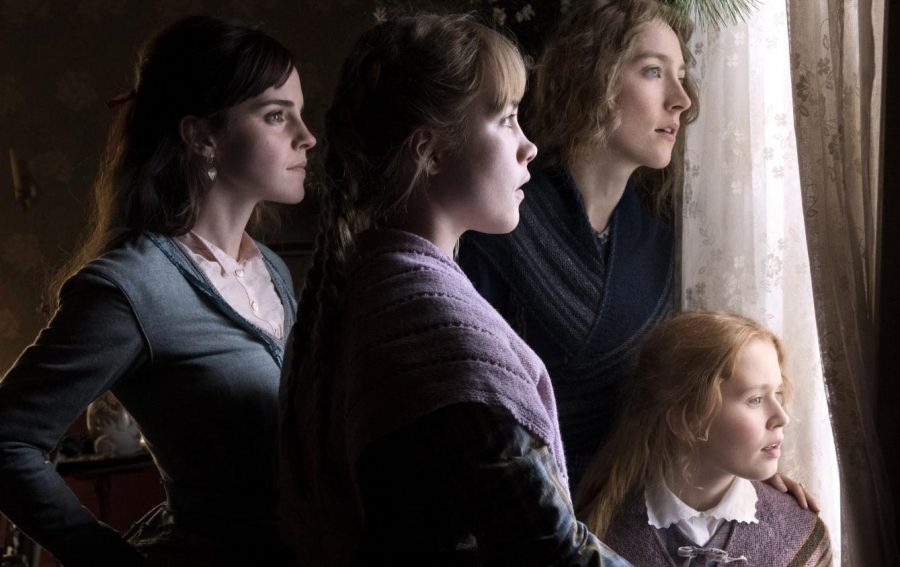“Little Women” Review
Even with recent Oscar noms, Little Women still isn’t getting the attention it truly deserves
The featured image of the promotional material for 2019’s “Little Women” (Left to right- Emma Watson, Florence Pugh, Saoirse Ronan, and Eliza Scanlen)
The issue of women being ignored in film awards ceremonies has attracted a much-needed spotlight recently, but it seems the Academy might’ve learned a thing or two, as 2019’s greatest movie was recently given Oscar nominations for Best Picture, Best Actress, Best Supporting Actress, Best Adapted Screenplay, Best Costume Design, and Best Original Score. Greta Gerwig, famous for Frances Ha and her award-winning directorial debut in Ladybird, has made one of many adaptations of Louisa May Alcott’s Little Women. While a nostalgic predisposition would say this film could never live up to Winona Ryder’s version, that sentiment couldn’t be more wrong. For adults and children, it’s already engaging enough, but for high schoolers and college students, this story of growing up and endless change will likely be one of, if not the most impactful of the year, maybe even the decade.
For the uninitiated, Little Women follows the exploits, ambitious or passive, of the sisters Jo, Meg, Amy, and Beth March, in Civil War America. With their father away at war, their mother, played by the exceptional Laura Dern, raises them in their impoverished home with a soft, charitable glove. Each sister seeks their own identity in their own way, with the only thing tethering them to reality being each other.
The film’s best quality is its tone, aided by a cornucopia of classical music, an original score by Alexandre Desplat, and every set piece imaginable from rolling hills and beaches to cozy homes and cityscapes. Every scene looks like a photorealistic interpretation of a late 18th-century painting, like something by Charles Curran. Frequent switches between a seven-year gap keep this endlessly-retold story interesting, using a warm, golden filter when filming the childhood scenes. Because of this and the use of natural light, these sections feel like warm blankets and Christmas mornings.
In contrast, the future sections use more muted, grayscale colors, but even with the minimal color palette, these sections feel ethereal, reinforcing the vast range of feel-good to heartbreaking moments. Most of the changes from flashback to future are easy to discern through characters changing their hair and the aforementioned filter, though a few are easy to miss if you’re not paying attention; it allows the audience to connect the dots and throws a loop to those who see movie theaters as a $5 nap.
The protagonist, Jo March, played by the up-for-best-actress Saoirse Ronan of Ladybird fame, seeks to avoid all feminine stereotypes and become a New York writer. Prideful and brazen, her loyalty and passion for writing make her a joy to follow. Ronan plays the perfect Jo for this generation. She portrays boyish and stubborn intensity, but it’s her extremely sensitive center that makes her great, playing a woman who knows she’s right, but is simply trying to live out her life the way she wants with the respect she deserves. She just wants to be left alone as a literary spinster, even if it comes at the cost of loneliness.
Emma Watson plays Meg, the oldest, who yearns for the domestic life and plays substitute matriarch for her sisters while their mother is working, hiding her desires for marks of elegance and beauty. Watson holds her own, despite being up against more interesting characters, and is, unfortunately, most interesting when in a scene with her sisters. She does, however, have one or two tear-jerker scenes that make her a mainstay in the film.
Midsommar’s Florence Pugh plays Amy March, who seeks to be the most renowned painter in the world and won’t settle for less. That is until she realizes she can’t make her own money or gain any fame for her artistic talent. The only thing she stands to gain is a suitable husband, though she struggles with it being an economic proposition for her family’s welfare, and not sacred as her younger self believed. Pugh delivers the film’s best performance as an immature, selfish child rapidly changing into a responsible, wise adult. Meg was considered the novel’s most wicked March sister, but by undercutting her self-indulgent child scenes for more screen time as a grown, respectable realist, Amy shines through. This is mostly thanks to Pugh’s portrayal, which more than deserves to win Best Supporting Actress.
Last is Beth, played by Eliza Scanlen, who takes a huge sideline besides showing up for small pieces of character development and plot points. Her personality boils down to her shyness, peacekeeping nature, and adoration for the piano. (Spoilers for a 151-year-old book) Beth’s death is not a huge spectacle since it’s surprise factor has long-since worn off in the past adaptations. Instead, Gerwig makes this a heartbreakingly accurate portrayal of mourning and loss, making this version of Beth’s end the most powerful out of every adaptation. Even with the obvious foreshadowing, tears are unavoidable. The supporting cast also holds a cavalcade of great performances from the likes of Timothee Chalamet as Laurie, Meryl Streep, and James Norton.
For transparency’s sake, it would be incorrect to call any of the sisters “bad” in terms of both performance and writing, so when I simplify Beth’s character, it’s only in the context of this movie, as Gerwig clearly made a conscious effort to give every sister their own share of the story.
Though it boasts a run time of 2 hours and 15 minutes, it still feels too short, not because the film didn’t give more than enough already or the plot had more places to go, but because spending more time in the immaculate world Gerwig- despite being overlooked for Best Director- fostered is such an satisfying experience. For those who enjoyed Ladybird from 2017 or just need a good movie to unwind after a long day, Gerwig provides her best work in the twilight of the previous decade, even if it’ll likely be overshadowed in the Oscars despite being inherently better than the majority of its competitors.






